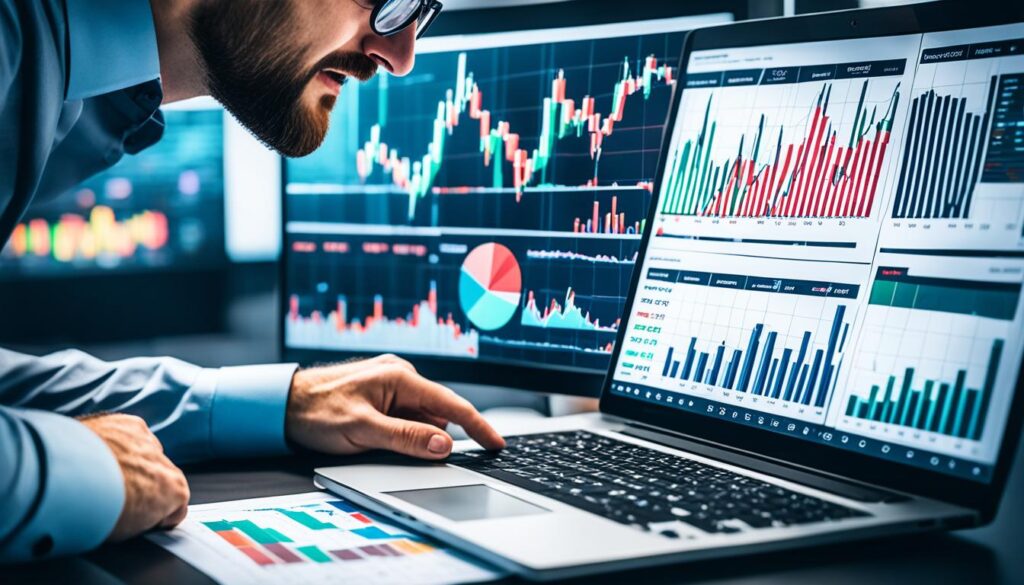
The cryptocurrency market is booming, with billions of dollars traded every day. It’s important for beginners to learn the basics of trading and how to handle its ups and downs. This knowledge is key to making smart choices in this fast-changing market.
Cryptocurrency trading means buying and selling digital assets like Bitcoin and Ethereum. The goal is to make money from changes in their value. There are many ways to trade, from short-term strategies to long-term investments.
Starting out, you should understand blockchain technology, the types of wallets, and trading platforms. Knowing these basics helps you make better decisions and manage risks in the market.
Remember, the cryptocurrency market is full of ups and downs. You could see big gains or big losses. It’s important to have a plan for managing risks and spreading out your investments.
This guide is for anyone new to cryptocurrency trading. It offers tips and insights to help you make smart choices. It aims to help you understand and benefit from this exciting market.
Choosing a Cryptocurrency Exchange
Choosing the right cryptocurrency exchange is key for beginners in digital asset trading. You need to think about several things to get a secure and easy trading experience.
Factors to Consider
When picking a crypto exchange, look at how easy it is to use, how secure it is, and the customer support. Also, check if you can use traditional money like US dollars to buy and sell. Good exchanges have easy interfaces, strong security like 2FA, and help when you need it. This makes users happy and keeps them coming back.
Top Exchanges for Beginners
For new traders, centralized exchanges like Coinbase, Binance, Kraken, KuCoin, OKX, and ByBit are great choices. They’re easy to use, have many cryptocurrencies, and are reliable. They also have strong security and help, which is great for beginners.
It’s smart to look into different exchanges and compare them. Think about things like fees, how you can put money in and take it out, and who watches over them. This will help you pick the best exchange for you.
Selecting Cryptocurrencies to Trade
Choosing the right cryptocurrency is key for trading success. It’s important to look at its technology, team, community, and market potential. This is called fundamental analysis. Beginners might start with well-known ones like Bitcoin, Ethereum, Solana, Polygon, Cardano, Avalanche, Dogecoin, and Tron. But, it’s also good to check out lesser-known ones for new chances.
When picking a cryptocurrency to invest in, think about the developers, its market cap, and how easy it is to trade. Bitcoin is very popular and widely accepted, with 21 million Bitcoins out there. Ethereum is also big, known for its smart contracts and apps.
| Cryptocurrency | Market Cap (USD) | Circulating Supply | Key Features |
|---|---|---|---|
| Bitcoin (BTC) | $1.08 trillion | 21 million | Most popular and widely accepted cryptocurrency |
| Ethereum (ETH) | $222 billion | 120.5 million | Blockchain network for smart contracts and decentralized apps |
| Solana (SOL) | $41 billion | 372 million | High-performance blockchain platform with low fees |
| Cardano (ADA) | $16 billion | 35 billion | Peer-reviewed protocol with a focus on security and scalability |
Doing deep fundamental analysis helps traders pick the best cryptocurrencies. Look at market cap, liquidity, and special features. Mixing it up by adding both well-known and new cryptocurrencies can help you make the most of the market.

Funding Your Trading Account
Starting your journey in cryptocurrency trading is exciting. One of the first steps is to fund your trading account. Luckily, many cryptocurrency exchanges have various deposit methods. These include traditional bank transfers, digital wallets, and payment platforms.
Deposit Methods
There are many ways to fund your crypto trading account. You can choose from:
- Bank transfers
- Credit/debit cards
- Digital wallets like PayPal or mobile money services
These deposit methods are easy and fast. They let you quickly add funds and start trading.
Starting Small
It’s smart for new crypto traders to start small when funding their accounts. This way, you can learn about the market without risking a lot of money. By starting small, you can develop your trading skills and gain experience before investing more.
Remember, risk management is key in the cryptocurrency market. It’s important to only invest what you can afford to lose. This keeps your financial safety during trading.
Finding Trading Opportunities
For beginners in cryptocurrency trading, technical analysis is key. It helps spot trading chances. By learning technical analysis, you can read charts, see patterns, and decide when to buy or sell.
Technical Analysis Basics
Technical analysis looks at past price changes and trading volume to guess future trends. Key ideas to grasp include:
- Candlestick charts – These show high, low, open, and close prices. They give clues about market feelings.
- Support and resistance levels – These are prices where the market often bounces back or breaks through.
- Trend lines – These lines link highs or lows to show the market’s direction.
- Indicators – Tools like moving averages and RSI help spot buy and sell signs.
Learning these basics lets you find trading chances in the cryptocurrency market. Remember, good trading also means being disciplined, managing risks, and knowing market trends and cycles.

| Technical Indicator | Description | Potential Trading Signal |
|---|---|---|
| Moving Average (MA) | A smoothed line that shows the market’s direction | Buy when price goes above the MA, sell when it goes below |
| Relative Strength Index (RSI) | Shows the speed of price changes | Buy when RSI is low, sell when it’s high |
| MACD (Moving Average Convergence Divergence) | A trend indicator that compares two moving averages | Buy when MACD crosses the signal line up, sell when it crosses down |
Using these technical analysis methods, you can find trading chances in the changing cryptocurrency market.
Risk Management Strategies
Successful cryptocurrency trading needs a solid risk management plan. As a dedicated crypto trader, I’ve found that key risk management techniques are crucial. They help me handle the unpredictable crypto markets.
First, I set clear stop-loss and take-profit levels for each trade. This limits my losses and secures gains, even when the market changes suddenly. For example, I might set a stop-loss 5% below my buy price and a take-profit 10% above. This keeps me from making emotional decisions based on market swings.
Another vital part of my crypto trading risk management plan is portfolio diversification. I spread my investments across different cryptocurrencies and asset types. This way, if one investment drops, others can balance it out and keep my portfolio stable.
Lastly, I keep a close eye on the overall market trends, especially Bitcoin. Big changes in Bitcoin can affect the whole crypto market. So, I adjust my investments based on these trends to stay ahead.
| Risk Management Technique | Description | Potential Benefits |
|---|---|---|
| Stop-Loss | Automatically sell a position when it reaches a certain loss threshold | Limits potential losses and protects capital |
| Take-Profit | Automatically sell a position when it reaches a certain profit target | Helps secure gains and prevent emotional decisions |
| Portfolio Diversification | Investing in a variety of cryptocurrencies and asset classes | Reduces the impact of individual losses and stabilizes overall portfolio |
| Market Monitoring | Closely tracking broader market trends, especially Bitcoin’s movements | Allows for timely adjustments to positions based on market conditions |
Using these crypto trading risk management strategies, I’ve grown more confident in trading cryptocurrencies. It’s not just about finding good trades. It’s also about managing risks well.

Cryptocurrency Trading Psychology
Trading in cryptocurrencies can be a wild ride, affecting both your wallet and your feelings. As a beginner, knowing how your mind works in trading is key to making good choices and succeeding.
Many traders struggle with the Fear of Missing Out (FOMO). This fear makes them act on gut feelings, not careful planning. To beat this, having a solid trading plan is vital. Stick to it, even when prices change fast.
Others also read this article : How to Set Stop Loss Levels in Cryptocurrency Trading
Overcoming FOMO
Trading cryptocurrencies can be emotionally tough, and knowing how your mind works is crucial. The big challenge is beating the Fear of Missing Out (FOMO), which can cause bad trading choices. To avoid this, make a clear trading plan and follow it, even when things move fast.
- Establish a clear trading strategy and risk management plan.
- Avoid making decisions based on emotions in trading, such as fear or greed.
- Set reasonable goals and stick to your plan, even when the market is volatile.
- Continuously educate yourself on the fundamentals of cryptocurrency trading.
Mastering your crypto trading psychology helps you handle the fast-paced cryptocurrency market. You’ll make choices that match your long-term financial goals.

Security Best Practices
Keeping your crypto trading safe is very important. This means keeping your digital wallets secure and choosing a safe place to trade cryptocurrencies. Using strong passwords, two-factor authentication, and keeping your private keys safe can lower the risk of hacking and theft.
Wallet Security
Storing your cryptocurrencies offline, or “cold storage,” can greatly reduce risks. This way, you’re not exposed to online threats. Adding extra security like fingerprint or facial recognition can make your digital wallets even safer.
Exchange Security
Choosing a secure cryptocurrency exchange is key. Look for exchanges known for protecting user data and assets. Some exchanges, like Kraken, keep 95% of your crypto in cold wallets to stop hackers. But, even trusted exchanges like Bitmart and Crypto.com have had security issues, causing big losses for users. Always check an exchange’s security steps, insurance, and how they handle attacks.
To keep your crypto trading safe, use a mix of security steps. Strong passwords, two-factor authentication, and offline storage can protect your digital money and lower risks.
| Security Measure | Description |
|---|---|
| Offline Storage (Cold Storage) | Storing digital currency offline to reduce exposure to online threats. |
| Two-Factor Authentication | Using extra security, like biometrics, to protect digital currency platforms and wallets. |
| Mobile Device Security | Setting up security rules with phone providers to stop hackers on devices used for crypto transactions. |
| Data Encryption | Encrypting devices, wallets, and backing up digital assets with encrypted drives for better security. |
| Due Diligence | Being careful online, making strong passwords, and researching platforms and wallets to avoid hacking and phishing. |
Tracking Market Trends
Keeping up with the fast-changing crypto market is key for smart trading. By watching and understanding trends, traders can spot chances and manage risks well. They use both fundamental and technical analysis for this.
Fundamental analysis looks at real-world use, tech progress, laws, and feelings in the market. It helps traders see if a crypto has a bright future. Technical analysis looks at past prices and patterns to find good times to buy or sell.
Combining these methods gives traders a full view of the market. This helps them make smart choices, handle risks, and grab new chances. Keeping an eye on the market and analyzing it often lets traders stay ahead and make smart moves.
| Fundamental Analysis | Technical Analysis |
|---|---|
|
|
By staying updated and using both fundamental and technical analysis, traders can move with confidence in the crypto market. This way of tracking trends is a great help for successful crypto trading.

Conclusion
Reflecting on my journey in cryptocurrency trading, I see the thrill and potential it offers. It’s a rewarding path, but beginners must approach it wisely. By learning about trading styles, picking a reliable exchange, and doing fundamental analysis, one can succeed.
Key advice is to start small, diversify, stay disciplined, and keep learning about market trends. Remember, trading is volatile and competitive. A good risk management plan is key to protecting your investments.
Starting your trading journey, I urge you to use these cryptocurrency trading tips for beginners. Stay focused on your goals with a strategic and disciplined mindset. This way, you can enjoy the exciting world of cryptocurrency trading and possibly earn rewards. Here’s to your summary of key points and future success!





